Access to Information and Privacy Statistical Report for 2023–24
On this page
Introduction
The Access to Information Act (ATIA) and the Privacy Act both came into effect on July 1, 1983.
Paragraph 70(1)(d) of the ATIA gives the President of the Treasury Board, as the designated minister, responsibility for collecting statistics and publishing a report containing a summary of those statistics on an annual basis. These statistics are used to assess the performance of the access to information (ATI) and privacy programs of the Government of Canada (GC).
This report presents statistical information submitted by institutions subject to the ATIA and Privacy Act, detailing the GC’s ATI and privacy programs across all federal institutions subject to the legislations from April 1, 2023, to March 31, 2024.
During the 2023-24 reporting period, the Canada Border Services Agency (CBSA) experienced an outage that impacted the accuracy of its ATI and privacy statistical data for the reporting period. As a result, the overall aggregate statistics and associated trends presented in this report were impacted due to incomplete data submitted by CBSA. More information about CBSA’s ATI and privacy programs can be found in its 2023-2024 Annual Report on the Access to Information Act and 2023–2024 Annual Report on the Privacy Act.
Every institution subject to the ATIA and the Privacy Act also tables an annual report in Parliament on the administration of each act. These reports can be found on institutions’ websites.
The complete statistical datasets for 2023–24 will be available on the GC’s Open Data Portal.
Exclusion of data from Immigration, Refugees and Citizenship Canada
Immigration, Refugees and Citizenship Canada (IRCC) accounted for 79.6% of ATI requests and 38.9% of personal information requests received by the GC in 2023–24 (including 81.3% of requests for personal information by foreign nationals outside Canada), the vast majority of which is related to clients’ immigration applications.
Because the nature and volume of requests received by IRCC differ significantly from the overall body of requests across the ATI and privacy system, IRCC’s data are excluded from this report.
More information about IRCC’s ATI and privacy programs can be found in its 2023-2024 Annual Report on the Access to Information Act and 2023–2024 Annual Report on the Privacy Act.
Key observations on volume of requests and performance
Access to information program data
With respect to requests made under the ATIA, in 2023–24, requests received decreased by 10.5% percent from the previous year, to 46,857; requests closed, by 1.4%, to 47,644; and requests carried over, by 19.3%, to 26,329. Pages processed increased by 25% from the previous year, to 10,326,722.
In terms of performance, at the government-wide level, 69.9% of ATI requests were closed within legislated timelines. At the institutional level, 58.9% of institutions met the performance target of closing 90% of ATI requests within legislated timelines.
Privacy program data
With respect to requests made under the Privacy Act, in 2023–24, requests received increased by 33.9% from the previous year and requests closed, by 31.1%, to 109,401 and 107,374, respectively. Requests carried over decreased by 7.5% from the previous year to 33,577. Pages processed increased from the previous year to 8,241,062.
In July 2022, the GC extended the right of access to all individuals, regardless of citizenship. This means that anyone in the world can submit a request for their personal information under the Privacy Act. In 2023–24, 9,571 personal information requests were received from foreign nationals outside Canada.
In terms of performance, at the government-wide level, 79.9% of requests for personal information were closed within legislated timelines. At the institutional level, 68.4% of institutions met the performance target of closing 90% of requests for personal information within legislated timelines.
Performance and statistical summary
Tables 1 to 4 provide a summary of results against key performance indicators and key data points for the ATI and privacy programs over the past three fiscal years, from 2021–22 to 2023–24.
| Key performance indicator | 2021–22 | 2022–23 | 2023–24 | Increase or decrease from 2022–23 to 2023–24 |
|---|---|---|---|---|
| Percentage of ATI requests responded to within legislated timelinesFootnote 1 | 70.7% | 72.3% | 69.9% | 2.4 percentage point decrease |
| Percentage of institutions that respond to 90% or more of ATI requests within legislated timelines | 55.8% | 54.2% Footnote 2 | 58.9% | 4.7 percentage point increase |
| Key performance indicator | 2021–22 | 2022–23 | 2023–24 | Increase or decrease from 2022–23 to 2023–24 |
|---|---|---|---|---|
| Percentage of personal information requests responded to within legislated timelinesFootnote 3 | 70.0% | 72.7% | 79.9% | 7.2 percentage point increase |
| Percentage of institutions that respond to 90% or more of personal information requests within legislated timelines | 64.2% | 60.8% Footnote 4 | 68.4% | 7.6 percentage point decrease |
| Data point | 2021–22 | 2022–23 | 2023–24 | Increase or decrease from 2022–23 to 2023–24 |
|---|---|---|---|---|
| Number of requests received | 45,334 | 52,377 | 46,857 | 10.5% decrease |
| Number of requests closed | 40,889 | 48,308 | 47,644 | 1.4% decrease |
| Number of requests carried over | 28,585 | 32,637 | 26,329 | 19.3% decrease |
| Number of extensions taken on closed requests | 15,198 | 16,747 | 16,960 | 1.3% increase |
| Percentage of requests closed with information disclosed | 79.8% | 79.5% | 73.8% | 5.7 percentage point decrease |
| Number of consultations received | 6,513 | 6,402 | 5,181 | 19.1% decrease |
| Number of consultations closed | 6,498 | 6,612 | 5,376 | 18.7% decrease |
| Number of pages processed for closed requests | 8,752,652 | 8,260,971 | 10,326,722 | 25% increase |
| Total cost of ATI program operations | $83,202,144 | $95,694,045 | $116,387,899 | 21.6% increase |
| Data point | Result: 2021–22 |
Result: 2022–23 |
Result: 2023–24 |
Increase or decrease from 2022–23 to 2023–24 |
|---|---|---|---|---|
| Number of requests received | 68,096 | 81,679Footnote 5 | 109,401Footnote 6 | 33.9% increase |
| Number of requests closed | 66,696 | 81,932 | 107,374 | 31.1% increase |
| Number of requests carried over | 36,535 | 36,301 | 33,577 | 7.5% decrease |
| Number of extensions taken on closed requests | 15,462 | 13,879 | 15,345 | 10.6% increase |
| Percentage of requests closed with information disclosed | 85.4% | 79.1% | 64.5% | 14.6 percentage point decrease |
| Number of consultations received | 196 | 177 | 134 | 24.3% decrease |
| Number of consultations closed | 214 | 171 | 130 | 24% decrease |
| Number of pages processed for closed requests | 8,532,891 | 7,717,559 | 8,241,062 | 6.8% increase |
| Number of reported material privacy breachesFootnote 7 | 427 | 305 | 581 | 90.5% increase |
| Total cost of privacy program operations | $67,509,390 | $73,346,139 | $99,188,449 | 35.2% increase |
Trend analysis
This section provides a trend analysis of results against key performance indicators and key data points for the ATI and privacy programs over the past 10 fiscal years, from 2014–15 to 2023–24. For material privacy breaches, data is only available starting in 2019–20.
Each radio button below corresponds to a trend graph of one or more of the key performance indicators and key data points. To view a graph, select one of the radio buttons.
Trend analysis of Access to Information program data
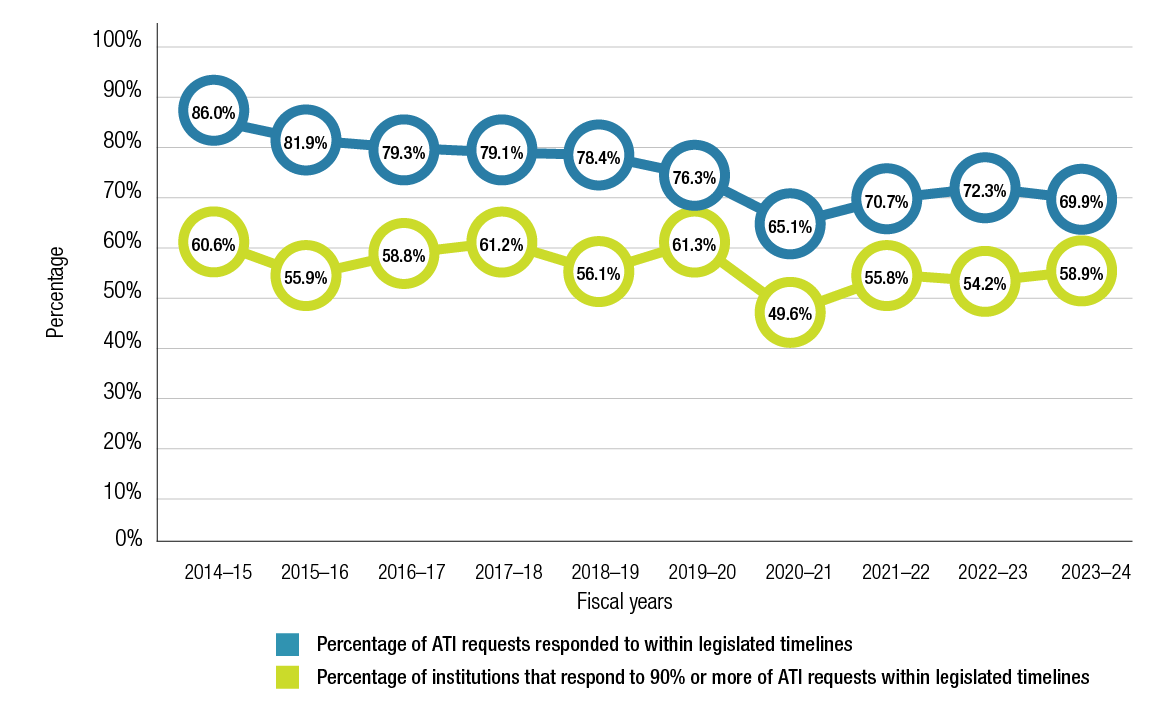
Figure 1 - Text version
| 2014–15 | 2015–16 | 2016–17 | 2017–18 | 2018–19 | 2019–20 | 2020–21 | 2021–22 | 2022–23 | 2023–24 | |
|---|---|---|---|---|---|---|---|---|---|---|
| Percentage of ATI requests responded to within legislated timelines | 86.0% | 81.9% | 79.3% | 79.1% | 78.4% | 76.3% | 65.1% | 70.7% | 72.3% | 69.9% |
| Percentage of institutions that respond to 90% or more of ATI requests within legislated timelines | 60.6% | 55.9% | 58.8% | 61.2% | 56.1% | 61.3% | 49.6% | 55.8% | 54.2% | 58.9% |
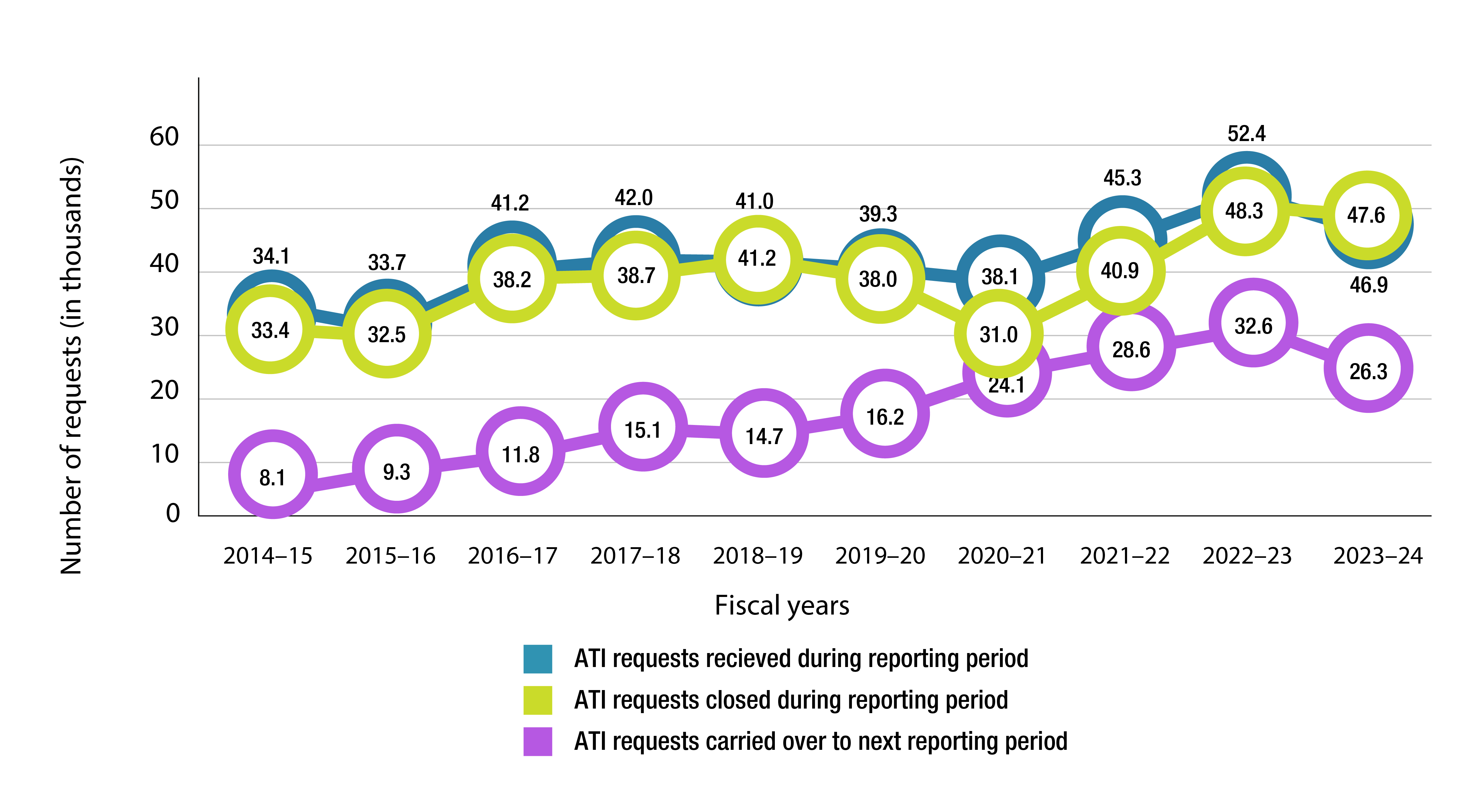
Figure 2 - Text version
| 2014–15 | 2015–16 | 2016–17 | 2017–18 | 2018–19 | 2019–20 | 2020–21 | 2021–22 | 2022–23 | 2023–24 | |
|---|---|---|---|---|---|---|---|---|---|---|
| ATI requests received during reporting period | 34,056 | 33,727 | 41,152 | 42,021 | 41,034 | 39,294 | 38,117 | 45,334 | 52,377 | 46,857 |
| ATI requests closed during reporting period | 33,412 | 32,474 | 38,175 | 38,684 | 41,165 | 37,977 | 30,989 | 40,889 | 48,308 | 47,644 |
| ATI requests carried over to next reporting period | 8,102 | 9,319 | 11,828 | 15,118 | 14,734 | 16,235 | 24,088 | 28,585 | 32,637 | 26,329 |
Figure 3 shows the breakdown of the 26,380 ATI requests that were carried over to 2024–25, by year of receipt and by status (that is, within or beyond legislated timelines, including when extensions were taken).
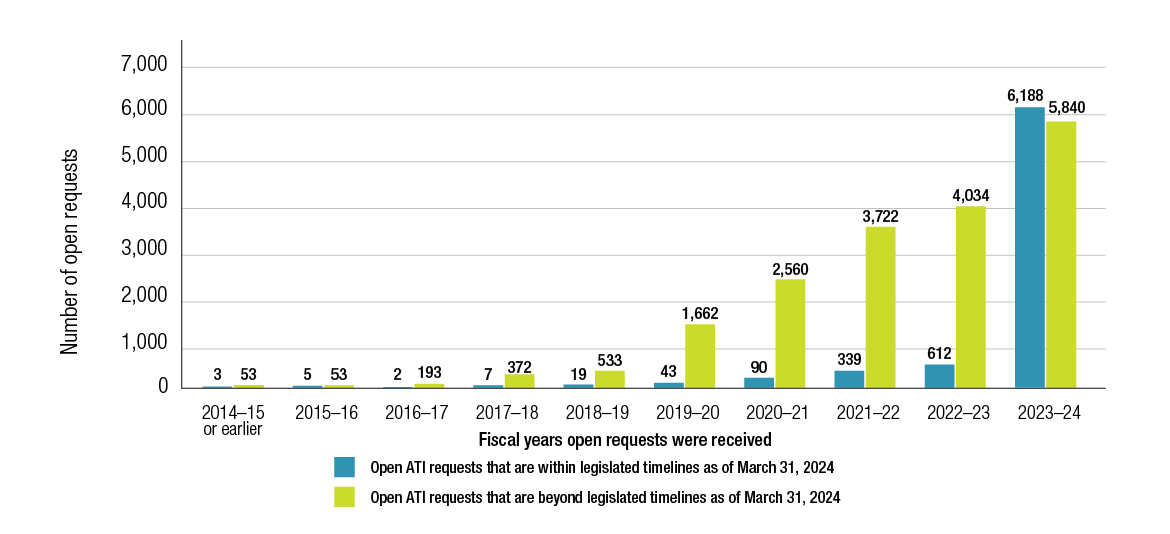
Figure 3 - Text version
| 2014–15 or earlier | 2015–16 | 2016–17 | 2017–18 | 2018–19 | 2019–20 | 2020–21 | 2021–22 | 2022–23 | 2023–24 | |
|---|---|---|---|---|---|---|---|---|---|---|
| Open ATI requests that are within legislated timelines (including extensions) as of March 31, 2024 | 3 | 5 | 2 | 7 | 19 | 43 | 90 | 339 | 612 | 6,188 |
| Open ATI requests that are beyond legislated timelines (including extensions) as of March 31, 2024 | 53 | 53 | 193 | 372 | 533 | 1,662 | 2,560 | 3,722 | 4,034 | 5,840 |

Figure 4 - Text version
| 2014–15 | 2015–16 | 2016–17 | 2017–18 | 2018–19 | 2019–20 | 2020–21 | 2021–22 | 2022–23 | 2023–24 | |
|---|---|---|---|---|---|---|---|---|---|---|
| 9(1)(a) - Interference with operations (ATIA) | 5,005 | 5,071 | 5,378 | 6,919 | 7,184 | 6,313 | 5,205 | 9,261 | 10,366 | 10,818 |
| 9(1)(b) - Consultation - Cabinet Confidence (ATIA) | 791 | 780 | 895 | 1,011 | 1,135 | 927 | 386 | 683 | 689 | 740 |
| 9(1)(b) - Consultation - Other (ATIA) | 3,499 | 4,024 | 5,026 | 4,741 | 5,132 | 4,164 | 2,467 | 3,041 | 3,479 | 3,437 |
| 9(1)(c) - Third-party notice (ATIA) | 1,867 | 1,677 | 1,907 | 2,038 | 2,288 | 2,319 | 1,688 | 2,213 | 2,213 | 1,965 |
Figure 5 shows the annual percentage of ATI requests closed where information was disclosed since 2014-15. This does not include requests with the disposition; no records exist, request transferred, request abandoned, neither confirmed nor denied, or decline to act with the approval of the Information Commissioner.
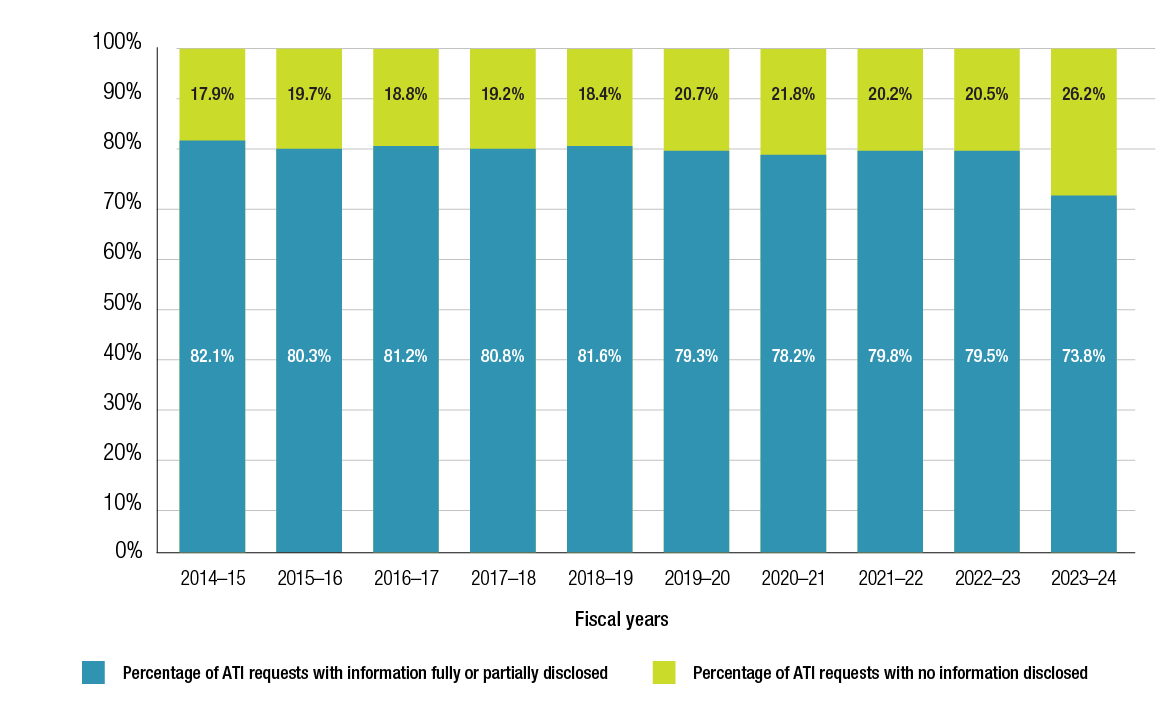
Figure 5 - Text version
| 2014–15 | 2015–16 | 2016–17 | 2017–18 | 2018–19 | 2019–20 | 2020–21 | 2021–22 | 2022–23 | 2023–24 | |
|---|---|---|---|---|---|---|---|---|---|---|
| Percentage of ATI requests with information fully or partially disclosed | 82.1% | 80.3% | 81.2% | 80.8% | 81.6% | 79.3% | 78.2% | 79.8% | 79.5% | 73.8% |
| Percentage of ATI requests with no information disclosed | 17.9% | 19.7% | 18.8% | 19.2% | 18.4% | 20.7% | 21.8% | 20.2% | 20.5% | 26.2% |

Figure 6 - Text version
| 2014–15 | 2015–16 | 2016–17 | 2017–18 | 2018–19 | 2019–20 | 2020–21 | 2021–22 | 2022–23 | 2023–24 | |
|---|---|---|---|---|---|---|---|---|---|---|
| Consultations received during reporting period | 7,702 | 7,839 | 8,300 | 9,064 | 9,394 | 9,869 | 4,759 | 6,513 | 6,402 | 5,181 |
| Consultations closed during reporting period | 7,649 | 7,853 | 7,922 | 8,605 | 9,068 | 9,643 | 4,696 | 6,498 | 6,612 | 5,376 |

Note: Pages processed spiked in 2017–18 because of one request of about 14.8 million pages. It spiked again in 2019–20 because one institution closed three requests on the same subject involving nearly 15 million pages in total
Figure 7 - Text version
| 2014–15 | 2015–16 | 2016–17 | 2017–18 | 2018–19 | 2019–20 | 2020–21 | 2021–22 | 2022–23 | 2023–24 | |
|---|---|---|---|---|---|---|---|---|---|---|
| Pages processed | 8,305,188 | 6,880,556 | 13,212,719 | 23,822,962 | 9,494,607 | 24,812,554 | 7,628,868 | 8,752,652 | 8,260,971 | 10,326,722 |
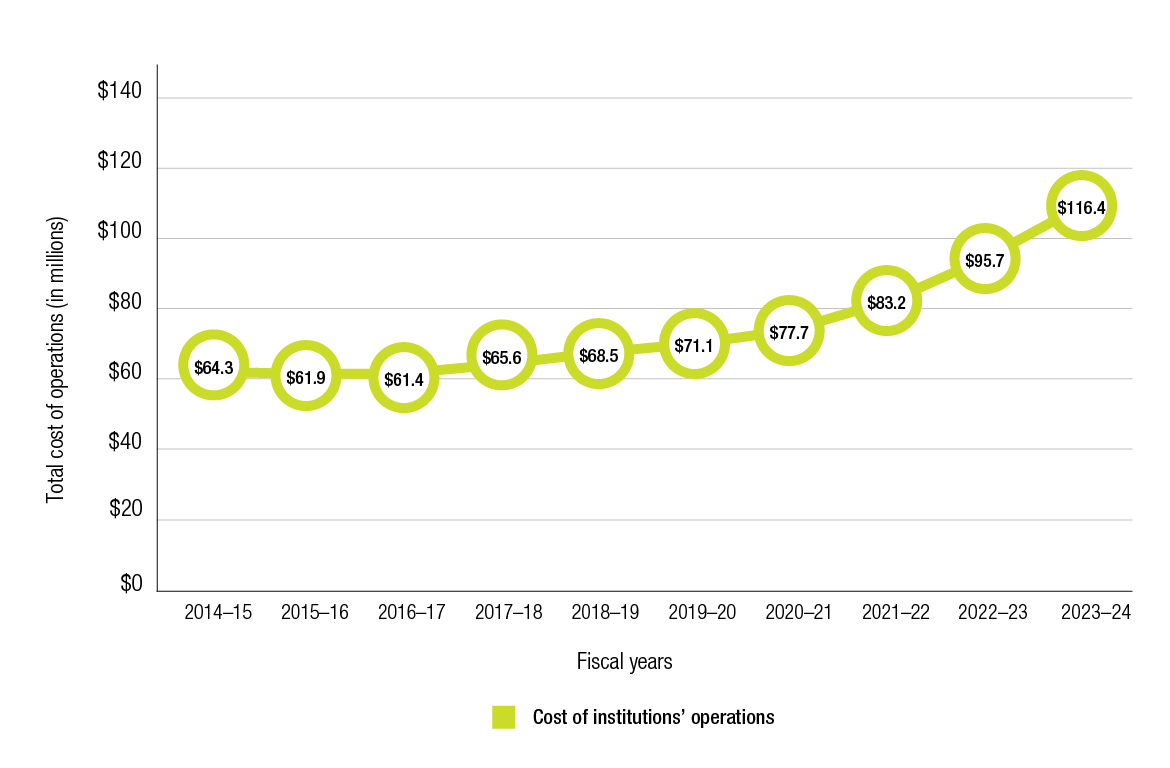
Figure 8 - Text version
| 2014–15 | 2015–16 | 2016–17 | 2017–18 | 2018–19 | 2019–20 | 2020–21 | 2021–22 | 2022–23 | 2023–24 | |
|---|---|---|---|---|---|---|---|---|---|---|
| Cost of institutions’ operations | $64,308,923 | $61,906,740 | $61,404,105 | $65,585,102 | $68,526,010 | $71,664,483 | $77,723,116 | $83,202,144 | $95,694,045 | $116,387,899 |
Trend analysis of Privacy program data

Figure 9 - Text version
| 2014–15 | 2015–16 | 2016–17 | 2017–18 | 2018–19 | 2019–20 | 2020–21 | 2021–22 | 2022–23 | 2023–24 | |
|---|---|---|---|---|---|---|---|---|---|---|
| Percentage of personal information requests responded to within legislated timelines | 81.2% | 78.9% | 81.9% | 78.4% | 80.7% | 85.2% | 62.9% | 70.0% | 72.7% | 79.9% |
| Percentage of institutions that respond to 90% or more of personal information requests within legislated timelines | 68.8% | 71.1% | 73.6% | 79.3% | 72.6% | 66.3% | 51.0% | 64.2% | 60.8% | 68.4% |

Figure 10 - Text version
| 2014–15 | 2015–16 | 2016–17 | 2017–18 | 2018–19 | 2019–20 | 2020–21 | 2021–22 | 2022–23 | 2023–24 | |
|---|---|---|---|---|---|---|---|---|---|---|
| Personal information requests received during reporting period | 53,608 | 55,541 | 57,885 | 54,599 | 58,911 | 62,578 | 55,137 | 68,096 | 81,679 | 109,401 |
| Personal information requests closed during reporting period | 50,554 | 55,002 | 53,905 | 48,876 | 58,028 | 58,881 | 49,178 | 66,696 | 81,932 | 107,374 |
| Personal information requests carried over to next reporting period | 13,567 | 13,830 | 18,456 | 24,192 | 25,046 | 28,826 | 34,751 | 36,535 | 36,301 | 33,577 |
Figure 11 shows the breakdown of the 33,577 personal information requests that were carried over to 2024–25, by year of receipt and by status (that is, within or beyond legislated timelines, including when extensions were taken).

Figure 11 - Text version
| 2014–15 or earlier | 2015–16 | 2016–17 | 2017–18 | 2018–19 | 2019–20 | 2020–21 | 2021–22 | 2022–23 | 2023–24 | |
|---|---|---|---|---|---|---|---|---|---|---|
| Open personal information requests that are within legislated timelines (including extensions) as of March 31, 2024 | - | - | 1 | - | - | - | 1 | 6 | 147 | 9,304 |
| Open personal information requests that are beyond legislated timelines (including extensions) as of March 31, 2024 | 70 | 65 | 219 | 1,098 | 2,415 | 2,834 | 2,761 | 3,484 | 4,178 | 6,992 |
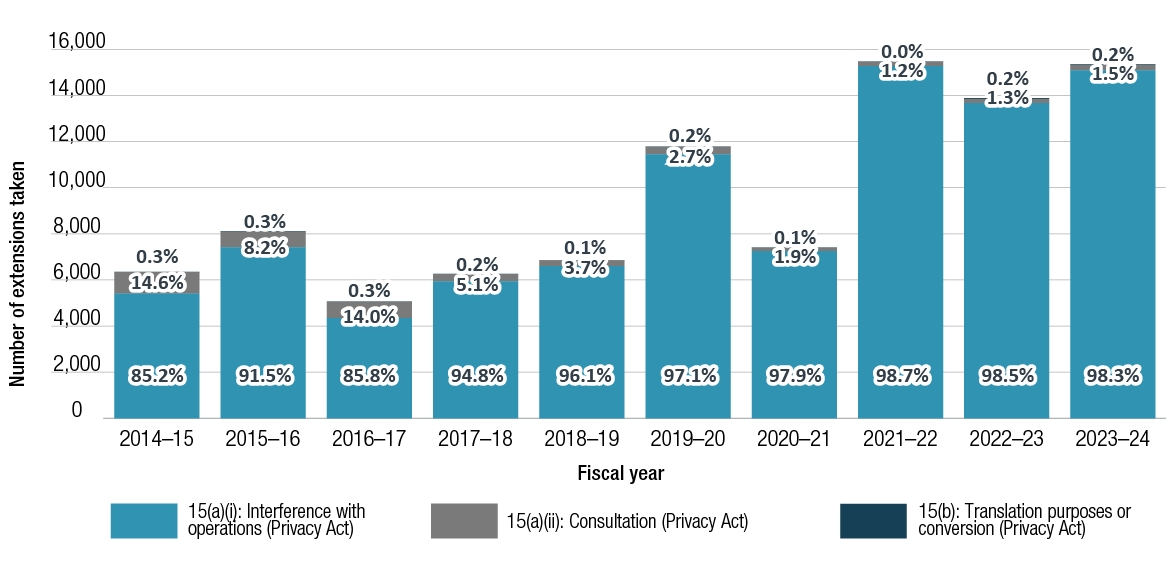
Figure 12 - Text version
| 2014–15 | 2015–16 | 2016–17 | 2017–18 | 2018–19 | 2019–20 | 2020–21 | 2021–22 | 2022–23 | 2023–24 | |
|---|---|---|---|---|---|---|---|---|---|---|
| 15(a)(i): Interference with operations (Privacy Act) | 5,408 | 7,414 | 4,339 | 5,939 | 6,594 | 11,441 | 7,243 | 15,267 | 13,671 | 15,090 |
| 15(a)(ii): Consultation (Privacy Act) | 925 | 665 | 707 | 317 | 255 | 316 | 144 | 192 | 176 | 225 |
| 15(b): Translation purposes or conversion (Privacy Act) | 16 | 23 | 14 | 10 | 10 | 20 | 11 | 3 | 32 | 30 |
Figure 13 shows the annual percentage of personal information requests closed where information was disclosed since 2014-15. This does not include requests with the disposition; no records exist, request abandoned, or neither confirmed nor denied.

Figure 13 - Text version
| 2014–15 | 2015–16 | 2016–17 | 2017–18 | 2018–19 | 2019–20 | 2020–21 | 2021–22 | 2022–23 | 2023–24 | |
|---|---|---|---|---|---|---|---|---|---|---|
| Percentage of personal information requests with information fully or partially disclosed | 90.5% | 86.3% | 87.8% | 85.9% | 85.9% | 87.2% | 86.7% | 85.4% | 79.1% | 64.5% |
| Percentage of personal information requests with no information disclosed | 9.5% | 13.7% | 12.2% | 14.1% | 14.1% | 12.8% | 13.3% | 14.6% | 20.9% | 35.5% |
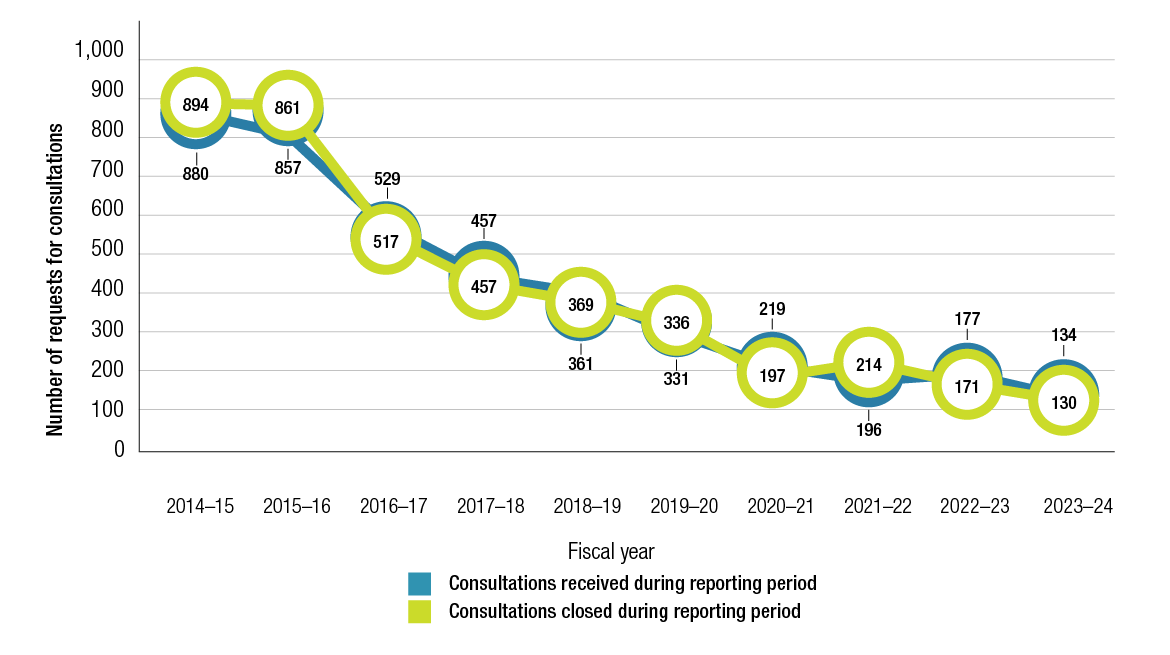
Figure 14 - Text version
| 2014–15 | 2015–16 | 2016–17 | 2017–18 | 2018–19 | 2019–20 | 2020–21 | 2021–22 | 2022–23 | 2023–24 | |
|---|---|---|---|---|---|---|---|---|---|---|
| Consultations received during reporting period | 880 | 857 | 529 | 457 | 361 | 331 | 219 | 196 | 177 | 134 |
| Consultations closed during reporting period | 894 | 861 | 517 | 457 | 369 | 336 | 197 | 214 | 171 | 130 |
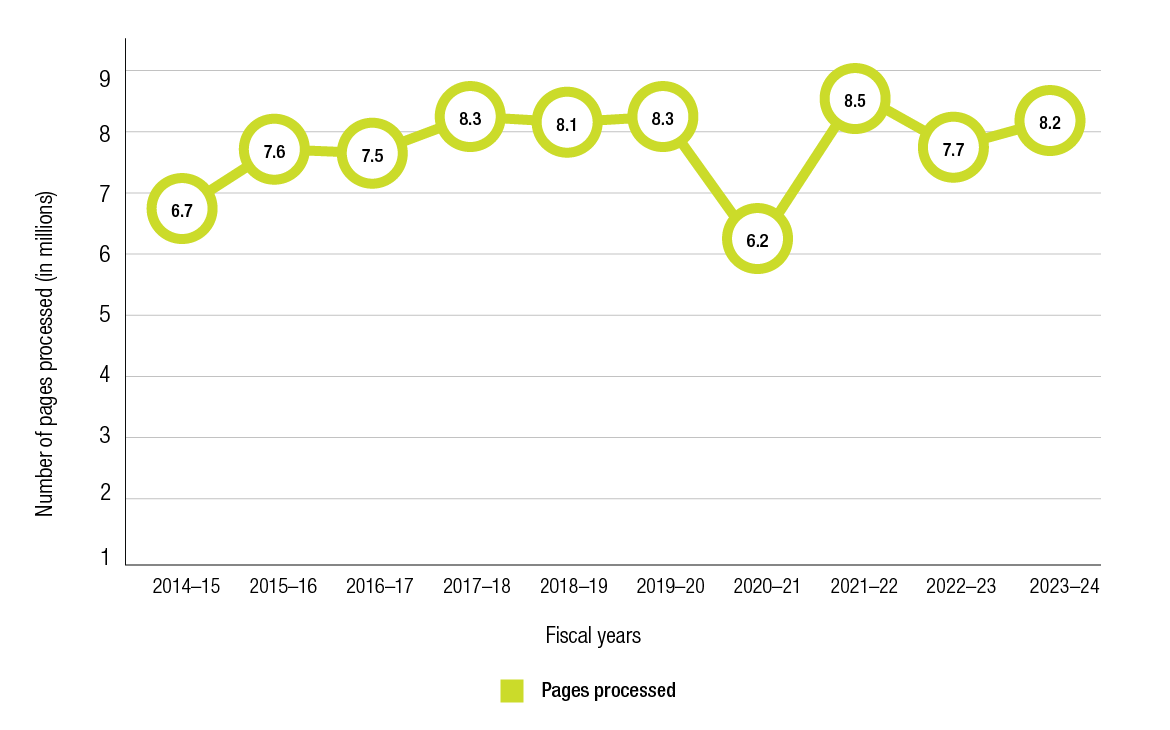
Figure 15 - Text version
| 2014–15 | 2015–16 | 2016–17 | 2017–18 | 2018–19 | 2019–20 | 2020–21 | 2021–22 | 2022–23 | 2023–24 | |
|---|---|---|---|---|---|---|---|---|---|---|
| Pages processed | 6,733,140 | 7,594,670 | 7,468,952 | 8,250,595 | 8,141,008 | 8,297,697 | 6,178,716 | 8,532,891 | 7,717,559 | 8,241,062 |
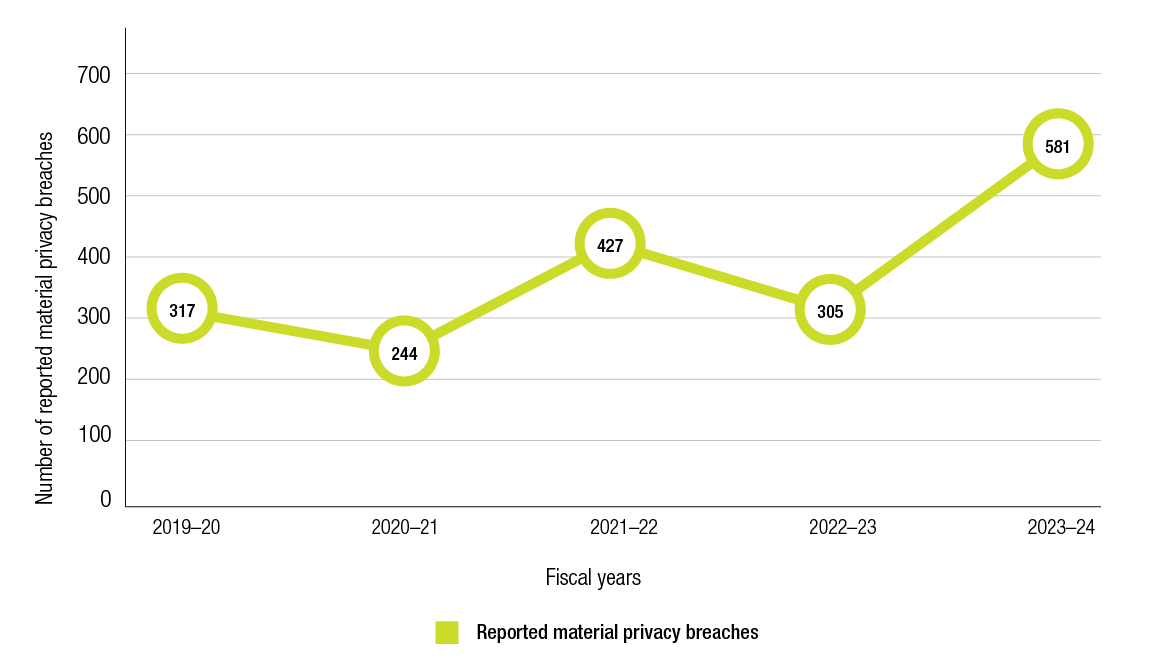
Figure 16 - Text version
| 2019–20 | 2020–21 | 2021–22 | 2022–23 | 2023–24 | |
|---|---|---|---|---|---|
| Reported material privacy breaches | 317 | 244 | 427 | 305 | 581 |

Figure 17 - Text version
| 2014–15 | 2015–16 | 2016–17 | 2017–18 | 2018–19 | 2019–20 | 2020–21 | 2021–22 | 2022–23 | 2023–24 | |
|---|---|---|---|---|---|---|---|---|---|---|
| Cost of institutions’ operations | $35,577,129 | $39,599,396 | $38,169,706 | $40,401,188 | $45,571,458 | $51,695,588 | $60,051,005 | $67,509,390 | $73,346,139 | $99,188,449 |